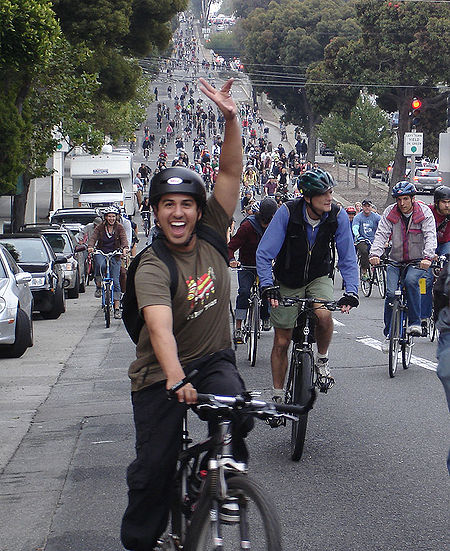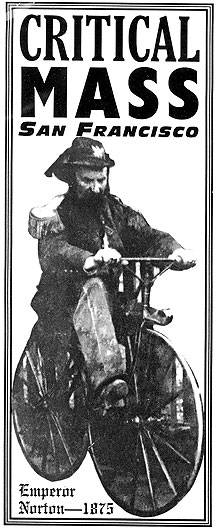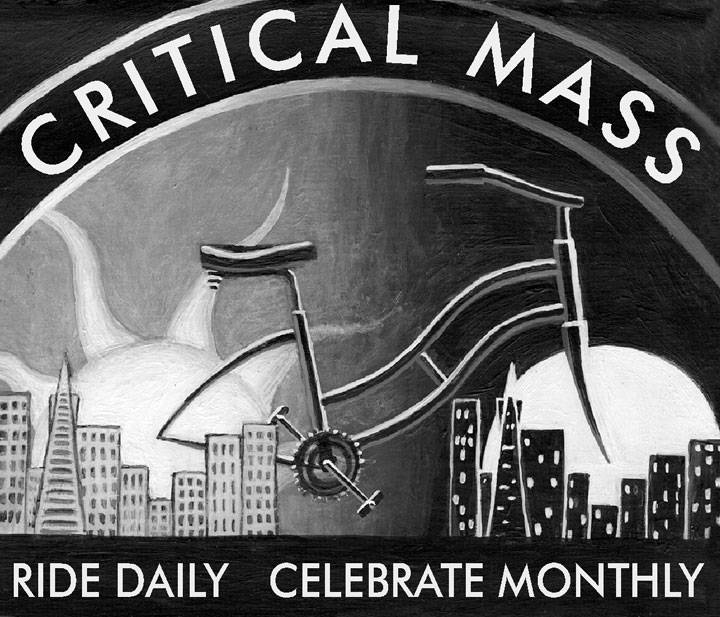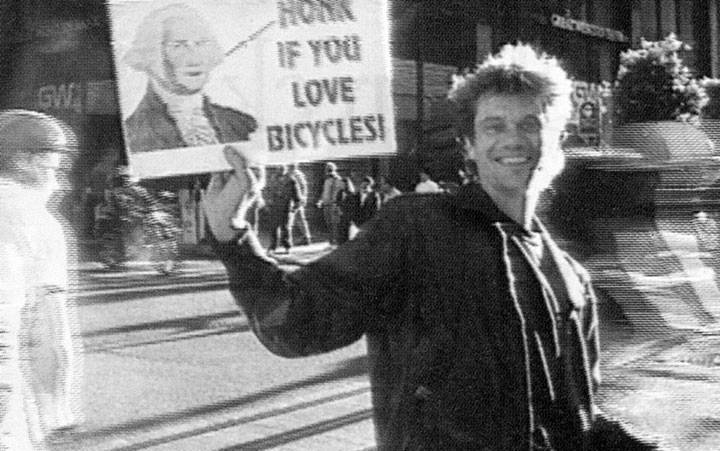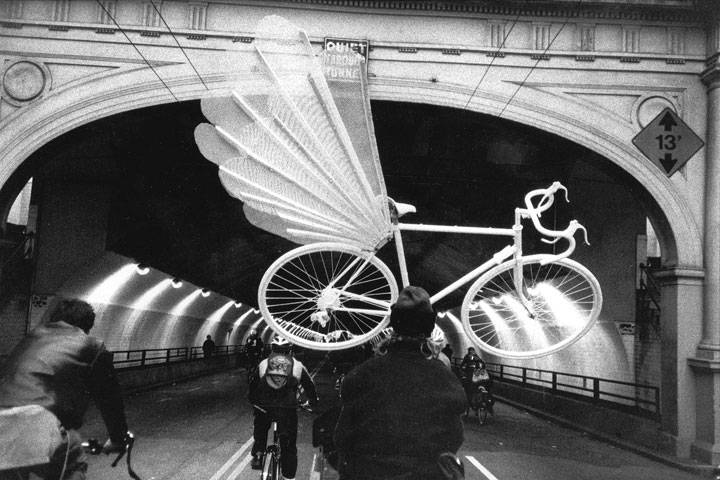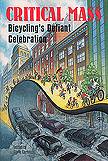Critical Mass: The Politics of Pleasure: Difference between revisions
(Created page with ''''<font face = Papyrus> <font color = maroon> <font size = 4>"I Was There"</font></font> </font>''' ''by Steven Bodzin'' [[Image:Cm van-ness-2007 00010.jpg|450px|right|'''Crit...') |
(added Richard Belcher video) |
||
| (3 intermediate revisions by the same user not shown) | |||
| Line 1: | Line 1: | ||
'''<font face = Papyrus> <font color = maroon> <font size = 4>"I | '''<font face = Papyrus> <font color = maroon> <font size = 4>"I was there..."</font></font> </font>''' | ||
''by Steven Bodzin'' | ''by Steven Bodzin'' | ||
[[Image:Cm van-ness-2007 00010.jpg|450px|right|'''Critical Mass on San Francisco's Van Ness Avenue, July 2007'''; ''Photo: Chris Carlsson'']] On a bright, hot day at the end of September, 1992, I arrived at Justin Hermann Plaza for the first Commute Clot, ready for a routine failure. I had left over 200 flyers on bicycles around the city over the previous week. (In 1992, that meant I hit every bike I saw.) I had given out a couple dozen more in person. It was a flyer I designed, and I was happy with it, but that was par for the course. | [[Image:Cm van-ness-2007 00010.jpg|450px|right|thumb|'''Critical Mass on San Francisco's Van Ness Avenue, July 2007'''; ''Photo: Chris Carlsson'']] On a bright, hot day at the end of September, 1992, I arrived at Justin Hermann Plaza for the first Commute Clot, ready for a routine failure. I had left over 200 flyers on bicycles around the city over the previous week. (In 1992, that meant I hit every bike I saw.) I had given out a couple dozen more in person. It was a flyer I designed, and I was happy with it, but that was par for the course. | ||
Experience had taught me to have low expectations. I had organized important demonstrations before, like the province-wide takeover of government offices to protest the logging of an old-growth forest in Ontario. Massive flyering and press outreach did what? In the case of the group I was in, it got eight people to show up to a single-room office on the outskirts of the city, where we spent five hours being pains in the neck until the police finally agreed to arrest two people. Sure, it made the national news, and it even helped stop the logging. But after the demo, we protesters each shrunk back to our isolated selves, craving a better world but unable to convince others to take part in creating it. | Experience had taught me to have low expectations. I had organized important demonstrations before, like the province-wide takeover of government offices to protest the logging of an old-growth forest in Ontario. Massive flyering and press outreach did what? In the case of the group I was in, it got eight people to show up to a single-room office on the outskirts of the city, where we spent five hours being pains in the neck until the police finally agreed to arrest two people. Sure, it made the national news, and it even helped stop the logging. But after the demo, we protesters each shrunk back to our isolated selves, craving a better world but unable to convince others to take part in creating it. | ||
| Line 13: | Line 13: | ||
At the SFBC table, I met a tall guy named Chris Carlsson. He told me his idea: A regular bike ride in the Financial District. I told him about my experience in the summer of 1990 in Boston. The locally based foreign aid group Bikes Not Bombs and an Edmonton-based activist named Tooker Gomberg got a group of people together to ride bikes and guilt-trip motorists. For the occasion, Bikes Not Bombs activist Carl Kurz and I wrote and designed a parking ticket that looked just like those on Boston windshields, but instead of “parking in crosswalk,” the listed infractions were more like “oil spills” and “species extinction.” After the fun and thrill of the first ride in Boston, the participants started riding every Tuesday morning. We generally had six to ten riders. We gave out our “Earth Violations” to any motorist who would take one, and we gave out “Certificates of Merit” to people on bikes, the bus, and the subway. It was a lot of fun, and we probably raised some consciousness around transportation choices. If nothing else, it was worth it for the smile on the face of the woman getting off a bus, who gushed, “My goodness, nobody’s ever given me a certificate of anything before!” | At the SFBC table, I met a tall guy named Chris Carlsson. He told me his idea: A regular bike ride in the Financial District. I told him about my experience in the summer of 1990 in Boston. The locally based foreign aid group Bikes Not Bombs and an Edmonton-based activist named Tooker Gomberg got a group of people together to ride bikes and guilt-trip motorists. For the occasion, Bikes Not Bombs activist Carl Kurz and I wrote and designed a parking ticket that looked just like those on Boston windshields, but instead of “parking in crosswalk,” the listed infractions were more like “oil spills” and “species extinction.” After the fun and thrill of the first ride in Boston, the participants started riding every Tuesday morning. We generally had six to ten riders. We gave out our “Earth Violations” to any motorist who would take one, and we gave out “Certificates of Merit” to people on bikes, the bus, and the subway. It was a lot of fun, and we probably raised some consciousness around transportation choices. If nothing else, it was worth it for the smile on the face of the woman getting off a bus, who gushed, “My goodness, nobody’s ever given me a certificate of anything before!” | ||
Chris’ style of activism was a shade different. Almost everything I said sparked him to argue with it on philosophical and pragmatic grounds. Guilt-tripping was a useless strategy, he said. Mornings are no time for demonstrations, when everyone has to get to work and nobody can stick around to hang out. Weekly rides are too frequent to draw real crowds. Raising consciousness among observers and the media doesn’t matter, he said. What matters is having fun and changing reality for those within the rides. And then he started talking about “work reduction.” As my eyes glazed over, I suggested he go to the next SFBC meeting. | [[Image:Norton xerocracy.jpg|left]] Chris’ style of activism was a shade different. Almost everything I said sparked him to argue with it on philosophical and pragmatic grounds. Guilt-tripping was a useless strategy, he said. Mornings are no time for demonstrations, when everyone has to get to work and nobody can stick around to hang out. Weekly rides are too frequent to draw real crowds. Raising consciousness among observers and the media doesn’t matter, he said. What matters is having fun and changing reality for those within the rides. And then he started talking about “work reduction.” As my eyes glazed over, I suggested he go to the next SFBC meeting. | ||
His ideas were eye-opening. I had never encountered this particularly California type of activism. I had always seen demonstrations as means to an end, not ends in themselves. I had always placed utopia in the future, following the struggle. Chris seemed to be hinting that the struggle itself can be the utopia. I started to understand the idea of “revolution of everyday life.” “The revolution will not be televised.” “Be the revolution.” “There is no way to peace, peace is the way.” These slogans moistened to life within me as I imagined hundreds of cyclists riding together, reclaiming the pavement for life. What could anyone do about it? Maybe it was possible to create the alternative world now, without waiting for some imaginary revolution. “How will you know when the revolution has happened?” my girlfriend at the time liked to ask. | His ideas were eye-opening. I had never encountered this particularly California type of activism. I had always seen demonstrations as means to an end, not ends in themselves. I had always placed utopia in the future, following the struggle. Chris seemed to be hinting that the struggle itself can be the utopia. I started to understand the idea of “revolution of everyday life.” “The revolution will not be televised.” “Be the revolution.” “There is no way to peace, peace is the way.” These slogans moistened to life within me as I imagined hundreds of cyclists riding together, reclaiming the pavement for life. What could anyone do about it? Maybe it was possible to create the alternative world now, without waiting for some imaginary revolution. “How will you know when the revolution has happened?” my girlfriend at the time liked to ask. | ||
| Line 23: | Line 23: | ||
So when I showed up at the “foot of Market,” I expected a dozen riders to be there, and that we would meet and have fun and the whole idea might go on for a couple months before petering out. Instead, four dozen people were there, and we had a great old time, riding in the golden evening light, ringing bells, hootin and hollerin, confusing the world with our happiness. | So when I showed up at the “foot of Market,” I expected a dozen riders to be there, and that we would meet and have fun and the whole idea might go on for a couple months before petering out. Instead, four dozen people were there, and we had a great old time, riding in the golden evening light, ringing bells, hootin and hollerin, confusing the world with our happiness. | ||
Sure enough, politics could be fun. Happy social environments would win what logical persuasion couldn’t. Afterwards, at Zeitgeist bar, many of us agreed we should do it again the next month. | |||
This revelatory joy persisted and increased as the months passed. I was awed to see people drinking and smoking pot and riding in a great mass together, and to see cops ignore the ride, and later escort the ride in an accommodating way. I got a goofy smile every time I heard someone talk about “this amazing bike ride I saw the other night.” Residents, riders, even many motorists seemed entertained and happy that this ride had been born. The lack of attention from cops and press made the whole thing feel like an underground growing in plain view, an alternative reality inviting everyone while living by new rules. | This revelatory joy persisted and increased as the months passed. I was awed to see people drinking and smoking pot and riding in a great mass together, and to see cops ignore the ride, and later escort the ride in an accommodating way. I got a goofy smile every time I heard someone talk about “this amazing bike ride I saw the other night.” Residents, riders, even many motorists seemed entertained and happy that this ride had been born. The lack of attention from cops and press made the whole thing feel like an underground growing in plain view, an alternative reality inviting everyone while living by new rules. | ||
| Line 56: | Line 56: | ||
For participants—the people who matter—Mass has helped inspire a decade of remarkably evolutionary activism, from Reclaim The Streets (now honored as an FBI-listed international terrorist group) to Seattle’s anti-WTO swarms. But for me, the ride has hit a point of diminishing returns. It is time to get beyond Critical Mass, to take the next step. We need to keep our imaginations open to what that can be. | For participants—the people who matter—Mass has helped inspire a decade of remarkably evolutionary activism, from Reclaim The Streets (now honored as an FBI-listed international terrorist group) to Seattle’s anti-WTO swarms. But for me, the ride has hit a point of diminishing returns. It is time to get beyond Critical Mass, to take the next step. We need to keep our imaginations open to what that can be. | ||
<iframe width="420" height="315" src="https://www.youtube.com/embed/-9oc7aQ_DRw?rel=0" frameborder="0" allowfullscreen></iframe> | |||
'''Critical Mass: "I shot this video together with journalist Jonathan Franklin over half a dozen last Friday of the month Critical Masses held in San Francisco for almost a year. It was my connection to the original San Francisco groovers and movers of these events. There is great Mass footage and funny interviews with cops, riders and pedestrian watching the parade of bikes go by."''' | |||
''Video: Richard Belcher'' | |||
[[Image:Bike-angel2-in-stockton-tunnel.jpg]] | [[Image:Bike-angel2-in-stockton-tunnel.jpg]] | ||
'''Bike Angel entering Stockton Tunnel during a Critical Mass ride some time in 1997.''' | '''Bike Angel entering Stockton Tunnel during a Critical Mass ride some time in 1997.''' | ||
[[Image:Cmbook cover thumb.jpg|left]] ''This short essay appeared originally in [http://www.akpress.org/criticalmassbicyclingsdefiantcelebration.html?___SID=U "Critical Mass: Bicycling's Defiant Celebration"] published on the 10th anniversary in 2002 by AK Press.'' | |||
[[Critical Mass Xerocracy|Prev. Document]] [[The Great Bicycle Parade of 1896 |Next Document]] | [[Critical Mass Xerocracy|Prev. Document]] [[The Great Bicycle Parade of 1896 |Next Document]] | ||
[[category:Bicycling]] [[category:1990s]] [[category:transit]] [[category:2000s]] [[category:dissent]] | [[category:Bicycling]] [[category:1990s]] [[category:transit]] [[category:2000s]] [[category:dissent]] | ||
Latest revision as of 20:35, 1 June 2015
"I was there..."
by Steven Bodzin
On a bright, hot day at the end of September, 1992, I arrived at Justin Hermann Plaza for the first Commute Clot, ready for a routine failure. I had left over 200 flyers on bicycles around the city over the previous week. (In 1992, that meant I hit every bike I saw.) I had given out a couple dozen more in person. It was a flyer I designed, and I was happy with it, but that was par for the course.
Experience had taught me to have low expectations. I had organized important demonstrations before, like the province-wide takeover of government offices to protest the logging of an old-growth forest in Ontario. Massive flyering and press outreach did what? In the case of the group I was in, it got eight people to show up to a single-room office on the outskirts of the city, where we spent five hours being pains in the neck until the police finally agreed to arrest two people. Sure, it made the national news, and it even helped stop the logging. But after the demo, we protesters each shrunk back to our isolated selves, craving a better world but unable to convince others to take part in creating it.
I was jaded, but this Commute Clot idea seemed worth trying. It was clever, and it sounded like it could even be fun. I first heard the notion two months earlier, in the same downtown plaza. The U.S. Department of Transportation was there, promoting alternatives to single-occupant vehicles. Folding tables were scattered about the plaza, each covered with stickers and buttons bearing guilt-trippy—or even nonsensical—slogans like “Bicycle for clean air” and “DON’T BE AN SOV!” The place bored me even as I entered it. I saw it as the kind of geeky, wonky event that was designed to flop. It offered no compelling reason for anyone to stop using a car. It was just lip-service to alternatives, even as the rest of the government teamed up with industry to support the ever-growing automobile juggernaut.
I visited the table set up by the San Francisco Bicycle Coalition, a group with which I had recently gotten involved. At my first meeting, there was a go-around in which participants told what bike advocacy they were up to. I explained that I had just gotten back from a bike trip across the US and then to the Earth Summit in Brazil, and that I could see bike advocacy was one of the keys to the whole sustainability movement. But the Bicycle Coalition was still tiny. A world of activist possibilities was present and necessary for the dozen people at that table. Bikes on transit, on bridges, on freeways. Bikes for the aged, the homeless, the working poor, the rich and famous. Bike parking, bike lanes, bike safety, bike races, bike education. Proper law enforcement, bike theft prevention, you name it. It was all in our dreams, and so little out in the world. It was at once exciting and overwhelming.
At the SFBC table, I met a tall guy named Chris Carlsson. He told me his idea: A regular bike ride in the Financial District. I told him about my experience in the summer of 1990 in Boston. The locally based foreign aid group Bikes Not Bombs and an Edmonton-based activist named Tooker Gomberg got a group of people together to ride bikes and guilt-trip motorists. For the occasion, Bikes Not Bombs activist Carl Kurz and I wrote and designed a parking ticket that looked just like those on Boston windshields, but instead of “parking in crosswalk,” the listed infractions were more like “oil spills” and “species extinction.” After the fun and thrill of the first ride in Boston, the participants started riding every Tuesday morning. We generally had six to ten riders. We gave out our “Earth Violations” to any motorist who would take one, and we gave out “Certificates of Merit” to people on bikes, the bus, and the subway. It was a lot of fun, and we probably raised some consciousness around transportation choices. If nothing else, it was worth it for the smile on the face of the woman getting off a bus, who gushed, “My goodness, nobody’s ever given me a certificate of anything before!”
Chris’ style of activism was a shade different. Almost everything I said sparked him to argue with it on philosophical and pragmatic grounds. Guilt-tripping was a useless strategy, he said. Mornings are no time for demonstrations, when everyone has to get to work and nobody can stick around to hang out. Weekly rides are too frequent to draw real crowds. Raising consciousness among observers and the media doesn’t matter, he said. What matters is having fun and changing reality for those within the rides. And then he started talking about “work reduction.” As my eyes glazed over, I suggested he go to the next SFBC meeting.
His ideas were eye-opening. I had never encountered this particularly California type of activism. I had always seen demonstrations as means to an end, not ends in themselves. I had always placed utopia in the future, following the struggle. Chris seemed to be hinting that the struggle itself can be the utopia. I started to understand the idea of “revolution of everyday life.” “The revolution will not be televised.” “Be the revolution.” “There is no way to peace, peace is the way.” These slogans moistened to life within me as I imagined hundreds of cyclists riding together, reclaiming the pavement for life. What could anyone do about it? Maybe it was possible to create the alternative world now, without waiting for some imaginary revolution. “How will you know when the revolution has happened?” my girlfriend at the time liked to ask.
Chris showed up at the SFBC’s headquarters, the back room of the Pot and Pan. The place was a greasy-spoon Chinese restaurant on 9th Avenue with harsh fluorescent lights and terrible acoustics. He and his grade-school daughter stayed only long enough to ask if the SFBC wanted to take charge of this ride. He suggested, “The last Friday of every month” as an off-hand possibility for when it would take place. The discussion went quickly against sponsoring the ride, based, at least on the surface, on concerns about liability. So Chris left, and I don’t think I saw him again until September 29.
Meanwhile, I was excited by the idea, and it didn’t seem like anyone was doing anything to make it real. So I made up a flyer, copied it, and gave it out. It wasn’t until two days before the ride that someone told me, “I saw the other flyer for that.” I was surprised, as I didn’t know another flyer existed. In fact, I didn’t see Chris’ flyer until over a month later.
So when I showed up at the “foot of Market,” I expected a dozen riders to be there, and that we would meet and have fun and the whole idea might go on for a couple months before petering out. Instead, four dozen people were there, and we had a great old time, riding in the golden evening light, ringing bells, hootin and hollerin, confusing the world with our happiness.
Sure enough, politics could be fun. Happy social environments would win what logical persuasion couldn’t. Afterwards, at Zeitgeist bar, many of us agreed we should do it again the next month.
This revelatory joy persisted and increased as the months passed. I was awed to see people drinking and smoking pot and riding in a great mass together, and to see cops ignore the ride, and later escort the ride in an accommodating way. I got a goofy smile every time I heard someone talk about “this amazing bike ride I saw the other night.” Residents, riders, even many motorists seemed entertained and happy that this ride had been born. The lack of attention from cops and press made the whole thing feel like an underground growing in plain view, an alternative reality inviting everyone while living by new rules.
Naturally, these hopes soon turned in part to annoyance. As the ride grew, I felt increasingly surrounded by hypocrites, by thoughtless people portraying themselves as thoughtful saviors. Even Chris, who had conceived of many of the good ideas for the rides, was far from immune to my annoyance.
Among the xerocrats, there was a hierarchy that was only partly voluntary. The dozens of people who put their own hours and love and worry and care into rides—even into early rides, when the shape of the event was still gelling—are mostly forgotten. Today, thanks to his exceptional devotion and his willingness to speak and argue, it is all “Chris Carlsson.” He is a mostly unwilling celebrity but a celebrity nonetheless. For all his disclaimers about not being “the leader,” he is still given credit for the ride.
Image: Beth Verdekal
But Chris gets only a small bit of my annoyance. My greatest annoyance is with the mental patterns of the riders. Despite having this open place where a new reality could be born, most people kept living by their normal rules of life. This was particularly true around leadership. Mass started looking to me like Orwell’s Animal Farm. At Mass, everyone is a leader, but some people are more leaders than others. Those of us who understood and took part in xerocracy led the gullible hordes. From the first ride on, most riders paid no attention to the overall route, expecting trained professionals to take charge of such details. I found it discouraging to learn that most people would rather attend a party than throw one, would rather sleep through life than take charge of it.
This same failure of imagination led to the growth of the “testosterone brigade.” This is the name given to those macho folks who race to the front of the ride and lead it wherever they feel ready to go. From what I hear, many Masses around the world are led entirely by this pack of spiteful dogs. In San Francisco, conscious effort has tamed them somewhat, but riders have nevertheless handed power to them far too often. Power is given, not taken. The riders who followed these jerks did so voluntarily. When they were leading the ride up the 18 percent grade of Powell Street and a few of us tried to divert riders onto an easier street, the mob just powered past our little call for a detour. I ended up attacking the hill with the slow riders at the back, parents with children, a rider with a stereo system, and a pedicab driver all cussing as they pushed up the hill. I rode off in a different direction, disgusted with the lemming mentality.
I believe that as the rides grew and there grew a clearer division between followers and leaders, followers took less and less responsibility for their actions. We figured out on the very first ride that it was safer and more fun to stick together and proceed through red lights. But it was also clear that we each needed to take responsibility for ourselves and for the ride. This meant using caution. Today, many riders blithely enter intersections without looking at the lights or the cross traffic, expecting others to protect them.
Similarly, some riders release pent-up anger at cars from the safety of the crowd. These people were rightly scolded by one rider, Kash, at the beginning of a ride. He yelled to the crowd, “Some people seem to think that Mass is a good place to take revenge on cars. It’s not. When I’m on my own, and someone attacks me, I take revenge. I do whatever it takes to ensure my safety and the ongoing safety of my friends. But when I’m here with my friends, this is a time to celebrate.” He told the riders to kill them with kindness. And he was right. The power dynamics of Mass are not those of everyday life. Having 1,000 friends around gives cyclists uncharacteristic power, and some have no idea what to do with it. Those who use the crowd for protection as they violate the humanity of motorists or pedestrians are not taking responsibility for themselves. It is yet another disappointment.
"Corking" during San Francisco Critical Mass with this sign usually led to an exchange of jocularity.
Photo: Ted White
These various annoyances led to a hilarious irony. As we flowed out of Justin Hermann on a spring ride in 1993, I was crowded in and I felt like a sheep. I felt surrounded by people who were taking part in revolution without any revolutionary sensibility. Rather than following their boss or their fashion magazine, they were following a route map that I had handed out. And it just came out—I started chanting, in my best sheep’s bleat, “Four wheels ba-a-a-a-ad, two wheels go-o-o-o-od.” I was making fun of people. Yet the chant was taken up, sheeplike, by those around me. It was painful to take in so many simultaneous layers of irony.
Finally, the “social space” that was one of Mass’ goals is only as good as the riders. Yes, we show that public space can be more than a traffic sewer. We live it as a social space, a political space, a place for the polis. In doing so, we could help revive democracy and civic life. I have met people after Critical Mass, including real friends. But in my usual after-work Friday evening haze, I am often in no state to energetically reach out and meet new people. When I have been, it’s been rewarding. But like so many other things, you only get out of Mass what you put into it. When I’m feeling grumpy or tired, I often find the ride alienating. I see many people casting about fecklessly for connection, like high schoolers in the cafeteria, nervously seeking a place to sit. Critical Mass is a civic space, but the ride itself is a poor place for intimate connection.
Finally, there is the relationship to the wider world. When I meet people who have seen the ride, they are often excited to learn that I do it. Spectators tend to have good feelings toward it, just as they do toward murals or a free clinic. But that’s about it. One non-participant recently summed it up well: “It’s one of those things I’m happy to see, but I don’t have time for. It’s part of the San Francisco I want to live in, but that doesn’t really exist anymore. I’m just glad that some people are doing it.” For many people, it is a comforting bit of counterculture spectacle, a salve that reminds them that they live somewhere really hip and cool and cutting edge, even if they spend their days at work and their nights surfing the Web. This is a condescending, compartmentalizing attitude that keeps any radical act from really breaking through.
For participants—the people who matter—Mass has helped inspire a decade of remarkably evolutionary activism, from Reclaim The Streets (now honored as an FBI-listed international terrorist group) to Seattle’s anti-WTO swarms. But for me, the ride has hit a point of diminishing returns. It is time to get beyond Critical Mass, to take the next step. We need to keep our imaginations open to what that can be.
<iframe width="420" height="315" src="https://www.youtube.com/embed/-9oc7aQ_DRw?rel=0" frameborder="0" allowfullscreen></iframe>
Critical Mass: "I shot this video together with journalist Jonathan Franklin over half a dozen last Friday of the month Critical Masses held in San Francisco for almost a year. It was my connection to the original San Francisco groovers and movers of these events. There is great Mass footage and funny interviews with cops, riders and pedestrian watching the parade of bikes go by."
Video: Richard Belcher
Bike Angel entering Stockton Tunnel during a Critical Mass ride some time in 1997.
This short essay appeared originally in "Critical Mass: Bicycling's Defiant Celebration" published on the 10th anniversary in 2002 by AK Press.

